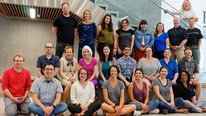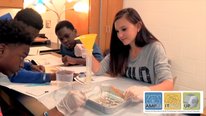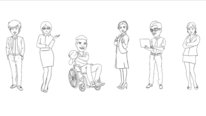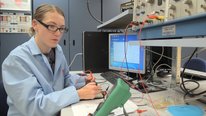- Isabel Huff
- http://www.teemsproject.com
- Curriculum Designer & Training Specialist
- Transforming Engineering Education for Middle Schools [TEEMS]
- https://teemsproject.com/
- TEEMS, Springfield Technical Community College
- Kaia Cormier
- Research Assistant
- Transforming Engineering Education for Middle Schools [TEEMS]
- https://teemsproject.com/
- TEEMS, Smith College
- Glenn Ellis
- Professor, Principal Investigator
- Transforming Engineering Education for Middle Schools [TEEMS]
- https://teemsproject.com/
- Smith College, TEEMS
- Sonia Ellis
- Instructional Designer
- Transforming Engineering Education for Middle Schools [TEEMS]
- https://teemsproject.com/
- TEEMS, Springfield Technical Community College
- Crystal Ford
- https://cford.myportfolio.com
- Digital Designer
- Transforming Engineering Education for Middle Schools [TEEMS]
- https://teemsproject.com/
- Smith College, Springfield Technical Community College
- Kate Lytton
- https://www.collaborative.org/events-and-courses/instructors/kate-lytton
- Director of Research and Evaluation
- Transforming Engineering Education for Middle Schools [TEEMS]
- https://teemsproject.com/
- TEEMS
- Becky Mazur
- https://www.collaborative.org/events-and-courses/instructors/rebecca-mazur
- Research and Evaluation Specialist
- Transforming Engineering Education for Middle Schools [TEEMS]
- https://teemsproject.com/
- TEEMS
- Beth McGinnis-Cavanaugh
- https://www.linkedin.com/in/mcginnis-cavanaugh/
- Professor, Principal Investigator
- Transforming Engineering Education for Middle Schools [TEEMS]
- https://teemsproject.com/
- Springfield Technical Community College, TEEMS
- Jeremy Pina
- Postdoctoral Fellow
- Transforming Engineering Education for Middle Schools [TEEMS]
- https://teemsproject.com/
- Smith College, TEEMS
- Al Rudnitsky
- Professor, Principal Investigator
- Transforming Engineering Education for Middle Schools [TEEMS]
- https://teemsproject.com/
- Smith College, TEEMS
Facilitators’
Choice Presenters’
Choice
Choice Presenters’
Choice
Public Discussion
Continue the discussion of this presentation on the Multiplex. Go to Multiplex
















Isabel Huff
Curriculum Designer & Training Specialist
Welcome to TEEMS--Transforming Engineering Education for Middle Schools! We're passionate about using story to integrate engineering in the science classroom. Our team is looking forward to answering questions about our work, and we'd also love to hear:
Deb Vanderpoel
I have worked with the staff and collaborators of TEEMS in the past. This video is a wonderful way to showcase their work, yet to see the engineering curriculum being used "live" is beyond amazing. Students are engaged collaboratively and really interested in solving the mysteries portrayed through an engineering lens. Honestly, I can't say enough about this project!
Glenn Ellis
Beth McGinnis-Cavanaugh
Jeremy Pina
Isabel Huff
Isabel Huff
Curriculum Designer & Training Specialist
Thank you so much, Deb! Looking forward to working with you more in the future.
Eric Schearer
I love the idea of storytelling. It works at any point in life.
The recently released I am Human Film about people with disabilities who use technology is an example of a story to tell.
https://www.iamhumanfilm.com/
Glenn Ellis
Isabel Huff
Isabel Huff
Curriculum Designer & Training Specialist
Thanks for sharing your work, Eric--we agree that storytelling is a powerful tool regardless of age. Your documentary looks fascinating! Looking forward to watching it.
Eric Schearer
Sure thing. It's not my work, but some colleagues in Cleveland.
Susan Kowalski
I love the way the teacher in the video described how the stories and scenarios allow students to wrap their minds around a problem and "become real problem solvers." That, to me, captures what engineering education is all about.
I'm interested in your PD - especially your plans for online PD. How long do you expect the PD to last, and how will you build a community of learners in the PD?
Glenn Ellis
Jeremy Pina
Isabel Huff
Becky Mazur
Research and Evaluation Specialist
Thank you, Susan! Our plans for PD are still emerging, and have been thrown for a bit of a loop by the pandemic. We are trying to design online PD that strongly supports teachers' learning needs, including those related to experiencing the power of story in a STEM learning context, generative dialogue with peer learners, and access to curriculum designers and content experts who can answer questions and provide feedback. How we do this, at least in the short term, depends somewhat on the capacity of our partnering district and teachers. Some of my other colleagues will likely want to give a more detailed response, and we will also be very happy to follow up as things become clearer.
Isabel Huff
Curriculum Designer & Training Specialist
Hi Susan, As Becky mentioned, we're still in the planning phase when it comes to online PD. We're planning on having some combination of:
Length of time would probably depend on the format of the PD--if it's something synchronous I can imagine it being a half-day or a full day (with some work offline); otherwise I think it would probably be shorter. We hope to find ways to foster community among educators, but I think that's sometimes challenging given what teachers already have on their plates.
Do you have experience planning or implementing online PD? If so, we'd love to hear about things you've found challenging or effective!
Susan Kowalski
We have been working to transform a face-to-face video-based analysis-of-practice PD model for online delivery. We've had the most success when we think really carefully about the rich interactions teachers have in the face-to-face environment, and then select the tools and activities to try to replicate those interactions online. We use a mix of asynchronous work (teachers working on their own between video conferences) and two-hour video conferences. Another critical piece is designing the questions and assignments that allow us as facilitators to uncover areas of confusion for teachers before a video-conference, and then tailoring the video-conference to attend to the issues of greatest need for the teachers. It has been a long journey, but we are seeing some promising early results.
Glenn Ellis
Isabel Huff
Becky Mazur
Beth McGinnis-Cavanaugh
Professor, Principal Investigator
Great points, Susan, which resonated with me as I've gone to remote teaching this semester! The social nature of teaching and learning is hard to replace or replicate online, and successful strategies for meaningful online PD will be valuable. Loved your project video--many similarities between our projects.
Annie Leonard
Hi TEEMS! I'm part of the CSforALL Springfield project. I like this story about a Smith student who built a race car. Like you, we are thinking about how to adjust our PD approach under remote learning circumstances, and considering ways to amp up what is available asynchronously (lesson modules, training videos for tools used in the modules, classroom videos of teachers piloting the modules...) as well as finding ways for synchronous learning and community-building as we bring new grade-level teachers on board next year, and for maintaining community for the teacher teams already formed. We should keep talking about this!
Glenn Ellis
Isabel Huff
Becky Mazur
Beth McGinnis-Cavanaugh
Professor, Principal Investigator
Hi Annie! Thanks for swinging by! Just watched the video on your project and commented that we should connect about success and challenges in implementation in SPS as well as assessment instruments and outcomes.
Florence Sullivan
Florence Sullivan
Hi Beth - I am a co-PI on the CS4All Springfield Project and a Professor at the College of Ed at UMass, Amherst. I'd love to connect with you about the TEEMS project and some of your team's idea about moving PD forward online. I've been a bit familiar with this project when it was in CT. You have some great partners in Al and Glenn from Smith. The idea of rooting engineering in stories about design disasters and biomimicry are really motivating for kids! A great project.
Glenn Ellis
Isabel Huff
Al Rudnitsky
Professor, Principal Investigator
Hi Florence. (is one allowed to just say 'hi' in this context?). I hope we can collaborate around some of this work. Always hearing great things about your work at UMass.
Florence Sullivan
Hi Al! Great to see this latest manifestation of your work. I love the story-based approach your group has taken in CT and now here in Springfield. I'd love to chat with you more about this work and find ways to collaborate.
Becky Mazur
Research and Evaluation Specialist
Thanks, Annie! Good idea. Let's find a way to share what we learn.
W. Adrion
Which schools are you working in?
Isabel Huff
Becky Mazur
Research and Evaluation Specialist
Hi Rick! We are working with 6th grade classrooms across the district (middle schools and one elementary) but in different ways. I'll send you some details.
Florence Sullivan
Florence Sullivan
Great to see you online, Becky! Yes, let's have our projects share ideas about online PD. What a crazy time. I love the TEEMS project - imaginative education! yay.
Glenn Ellis
Kaia Cormier
Isabel Huff
Becky Mazur
Margo Murphy
Science Instructor
Nice video! I love the use of story/ storylines. I have a couple of questions.. I am also interested in know how many schools you are working with. and What materials and software are needed? Are you planning any additional units? Thanks!
Glenn Ellis
Jeremy Pina
Isabel Huff
Crystal Ford
Digital Designer
Hi Mary! Thanks for the great questions! For the pilot year, we were working with a relatively small group of about 6 schools, but we hope to expand that over the next year.
All of our resources are available for free online at http://goteems.com (our curriculum) and at http://teemsproject.com (a resource site for teachers which includes lesson guides). We’ve tried to make make the curriculum as versatile as possible for educators. A computer or a phone is needed to watch the videos, but no software is needed. Our other resources can be accessed through the websites and either projected on a screen or printed.
In addition to the 1 engineering unit and 5 lessons already available, we have one additional unit and one lesson in the works that we will be adding to the site before the end of this summer. The unit will focus on materials and biomimicry and the lesson centers around waves. Let us know if you’d like any additional details! :)
Jeremy Pina
K. Renae Pullen
Specialist
This project is EXCITING! Can you share the professional learning opportunities you created for teachers/leaders who are a part of TEEMS? Thanks.
Glenn Ellis
Kaia Cormier
Jeremy Pina
Isabel Huff
Isabel Huff
Curriculum Designer & Training Specialist
Thanks for your kind words and your question! We had hoped to run an in-person professional development workshop with teachers from our implementing schools last summer, but unfortunately conflicting schedules didn't allow us to do so. Instead, we sent out resource packets to teachers, and then I met with each one individually to talk about the project. I also met with teachers periodically throughout this year to get informal feedback, answer questions, and bring them new lessons as we developed them.
Our plan was to host an in-person PD workshop this summer, but that again looks unlikely. However, it was part of our grant that in years 3-4, we would develop online PD. We have moved up the timeline for that and plan to spend this summer developing resources, including videos that explain major ideas from each unit/lesson, videos that cover the logistics of each unit/lesson, etc. We may also try to host a remote, synchronous workshop.
We'd love to hear your ideas if you have any to share: what do you think is particularly important for teacher/leader professional development, especially if delivered remotely?
K. Renae Pullen
Jeremy Pina
K. Renae Pullen
Specialist
If I were doing this for the first time, I'd love to engage in the program, collaborate with colleagues who are also a part of the project, chat with folks like you, and look at classroom videos of design challenges & student work. I do like the idea of a remote, synchronous workshop.
I appreciate you had follow-up and informal conversations. I know it isn't the most sexy data, but it is so important.
Isabel Huff
Sonia Ellis
Isabel Huff
Curriculum Designer & Training Specialist
Thank you for this advice!!--and yes, absolutely agreed about informal conversations. We learned a lot from teachers about what worked and didn't work, where we needed to provide more information or support, etc. I always think about teachers as the "superheroes," and our job as giving them the tools that allow them to be creative and maximize their talents.
K. Renae Pullen
Lynda McGilvary
Communications Director
This is a great way to capitalize on youthful imagination and channel it into productive learning! I work with Indigenous youth, so the storytelling aspect of this project drew my attention. Storytelling is inherent in many Native American cultures. Did you consider that as you were developing this project?
Jeremy Pina
Isabel Huff
Sonia Ellis
Instructional Designer
Hi Lynda, thanks for visiting! In our work, one of the major theories we’re implementing in this project is called Imaginative Education (IE), which was developed by educational researcher Kieran Egan. A great overview of IE is provided by CIRCE (Centre for Imagination in Research, Culture and Imagination) at http://ierg.ca/about-us/a-brief-guide-to-imaginative-education/. IE involves using stories – appropriate to the students’ age and development -- that engage their emotions and imaginations. We have found this to be a powerful way of providing students with context and the ability to make meaning out of their learning experience. In IE, stories that most engage middle-schoolers include elements such as extremes of reality, heroism, and a sense of mystery – all of which we incorporate into the storylines that are the backbone of each unit and lesson. While we didn’t intentionally draw from the rich storytelling in Native American Culture, I would love to hear more about your work and any thoughts you might have about how our approach could best resonate with and engage Indigenous youth.
Jeremy Pina
Jeremy Pina
Postdoctoral Fellow
Reinforcing what Sonia has mentioned and highlighting an insight you had, Lynda, the theory of Imaginative Education does seem to me to dovetail very meaningfully with storytelling practices represented in the Indigenous teaching and learning context.
And there's a bit of research already out there to back up this position: In 2005, there was some research carried out in British Columbia that looked at implementing Imaginative Education at schools within the Stó:lõ, Haida and Ts’msyen First Nations communities. If you're interested in looking into it further, I'd recommend as a starting point Nielsen's (2010) article Lost in translation? which provides a summary of the Learning for Understanding through Culturally-Inclusive Imaginative Development (LUCID) project.
All this is to say, working with Indigenous communities is something that does seem like good fit and it's something that's been on our radar in a broad sense. :)
Sonia Ellis
Al Rudnitsky
Professor, Principal Investigator
Hope I don't get into too much trouble commenting on our project's video. Just wanted to commend my TEEMS teammates on the quality of their responses. Visiting other videos has been very interesting (too). Reinforcing to see so many projects incorporating story in their work.
Kaia Cormier
Becky Mazur
Beth McGinnis-Cavanaugh
Brian Kruse
Thank you for sharing your project! I really like how narrative is an important part of the design process. It seems like every story has some aspect of problem solving, perhaps not an engineering problem, but something to solve nonetheless. So it is only natural to create scenarios where engineering is an integral part of the story, with the outcome dependent on what the learners design.
Kaia Cormier
Jeremy Pina
Postdoctoral Fellow
Thank you for your kind words, Brian. Narrative really is important for orienting students to engage with the problem-solving processes that are embedded in engineering design. The challenge is always to create the kind of interaction that allows students to explore and discuss solutions meaningfully as they work through their process. It can be a lot of work -- particularly when there's conceptual matter that doesn't necessarily lend itself to the kinds of narratives that middle school students will approach easily -- but our development team does a great job of finding that balance.
Catherine Stimac
I love the place-based problem solving scenarios, along with the storytelling as I would think that strengthen's engagement. I also appreciate hearing from the students. Well done, TEEMS!
Kate Lytton
Director of Research and Evaluation
Thanks so much for visiting. Yes, storytelling is central to the Imaginative education approach. See the Imaginative Education Research Group (at http://ierg.ca/about-us/a-brief-guide-to-imaginative-education/) for a great overview. That type of engagement combined with the hands on, real-life projects provide an approach to engaging students in a fun way, that invites them to actively apply the conceptual learning. Teachers clearly describe the strengths of this approach relative to a more traditional curriculum. Before the pandemic, we were just starting our classroom observations with a tool designed to assess engagement.
Melissa Zeitz
I really love that they are going to be using storytelling to solve real world problems. I am excited that you are in the Springfield school system too. If this curriculum is anything like your last one, I know your students must be having an amazing time interacting with it. Our students still love reading Talk to Me and interacting with that book. Have you started to think about what this approach would look like remotely?
Beth McGinnis-Cavanaugh
Becky Mazur
Sonia Ellis
Instructional Designer
Thanks so much for your encouraging comments - and I'm delighted to hear that students are still reading and enjoying Talk to Me! Yes, we've begun taking steps toward transitioning to a remote delivery. As we talked about above, we're working on developing online PD with video tutorials and support on the logistics of delivering the content. We're also looking at how our online, transmedia resources for students could be used by students at home, with less direct teacher guidance. We've just started trying this out (if you're interested, we're experimenting at teemscurriculum.wordpress.com). We're continuing to brainstorm this transition - and definitely will be seeking input from teachers on the kinds of resources that would work best for them and on what makes a workable remote lesson. (And we would be very appreciative of any words of advice you might have, here or separately!)
Christine Sachs
The blend of storytelling and engineering is such a great way to engage students. I will be interested to see the STEM identity findings. Thank you for creating this important project at the middle school level!
Kaia Cormier
Sonia Ellis
Instructional Designer
Thank you, Christine! Yes, the STEM identity part of the project is particularly exciting to me – as a one-time chemical engineer who never felt a sense of self-efficacy or community during my education or employment in that field. But seeing so many great projects in this showcase that recognize the need to engage student populations that are often neglected – that is very heartening!
Christine Sachs
Jessica Gale
Fantastic video. You noted that you are also looking into student identity - do you happen to have any preliminary thoughts on how TEEMS may be influencing student identity related to STEM and/or engineering? It sounds like you have selected some engaging stories to pique student interest. I wonder if there might also be room for students to share, create, or connect with their own stories and experiences.
Becky Mazur
Jeremy Pina
Jeremy Pina
Postdoctoral Fellow
Hi Jessica! I wanted to complement Isabel's response to your question with a bit of information about how we're looking at how we're looking at the effect of TEEMS on students' identities:
As part of our overall research plan, we're looking at elements related to students' self-reported STEM identity development -- these would be indicators like engineering self-efficacy and development of career awareness.
We're also exploring identity development in classroom observations by looking at cognitive engagement. This gets a little more directly at what you've mentioned -- that we can capture students' efforts to demonstrate their engagement (through sharing, creating, reflecting, and discourse) in an authentic setting as they're experiencing the learning narratives.
Isabel Huff
Curriculum Designer & Training Specialist
Hi Jessica--thanks for your great questions! I'm going to pass the identity part of your question to one of our evaluators. However, when it comes to students sharing or connecting with their own stories, we've tried to do this in a few ways (and hope to find ways to do it more!):
We're always interested in ways to more deeply engage and connect with students. Do you have experience or ideas about meaningful ways for students to share or create stories?
Jessica Gale
Hi Isabel - Thank you for your thoughtful response. These are great connections. Any time we can engage students in using engineering to solve problems that matter to them, I get very excited. Sometimes problems matter because students discover them in their homes and communities. Other times I think you can provide a context that fosters that sense of ownership and relevance. It sounds like you are finding some creative ways to do that. I'm looking forward to following this work.
Becky Mazur
Research and Evaluation Specialist
Hi! As the project's evaluator, I want to briefly chime in about the issue of student's STEM/engineering identity. One thing project designers are very aware of is the fragility and/or lack of student's understanding of what engineers do/how they contribute to society -- a fundamental precursor to forming a sense of engineering identity. Therefore, part of the project's theory of change is related to immersing students very explicitly (through story, and through other instructional strategies) in the language and practice of engineering, and specifically ways that engineers contribute meaningfully to people's (or animal's) lives. Then there is a self-efficacy component (i.e., am I capable of participating in engineering), and our theory is that this are more likely to emerge/develop through experiences that require high levels of cognitive engagement. That's it in a nutshell -- happy to talk more about this if you have questions and/or ideas!
Glenn Ellis
Professor, Principal Investigator
Thanks, Jessica. And you're right--at the heart of this is getting students to develop a sense of ownership and relevance. This supports both deep learning and the development of STEM identity.
Amanda Gunning
I just started teaching a graduate education course - Engineering for the K-12 classroom, which I designed. I would love to include your project and research in what I share with my teachers. I love that the focus of your project is MS, this is a grade band that I have found to be one of greatest need, with students who are most vulnerable to dropping out of the pipeline. This is an exciting and innovative project!
Beth McGinnis-Cavanaugh
Professor, Principal Investigator
Thanks, Amanda--happy to hear that you'll include #TEEMS in your course! Please let us know if we can provide any input or resources. We'd be happy to do a live session with your students about any aspect of the project!
And, agreed--the middle school years are critical with respect to STEM trajectories. TEEMS is designed for the middle school grades based on what we've learned from teachers about the tremendous need for more resources at that level—particularly those that integrate science and engineering in meaningful ways and engage girls as well as boys.
Amanda Gunning
Eric Hamilton
This is a great video, and the project is more than timely. Thank you.
Isabel Huff
Curriculum Designer & Training Specialist
Thank you so much, Eric!